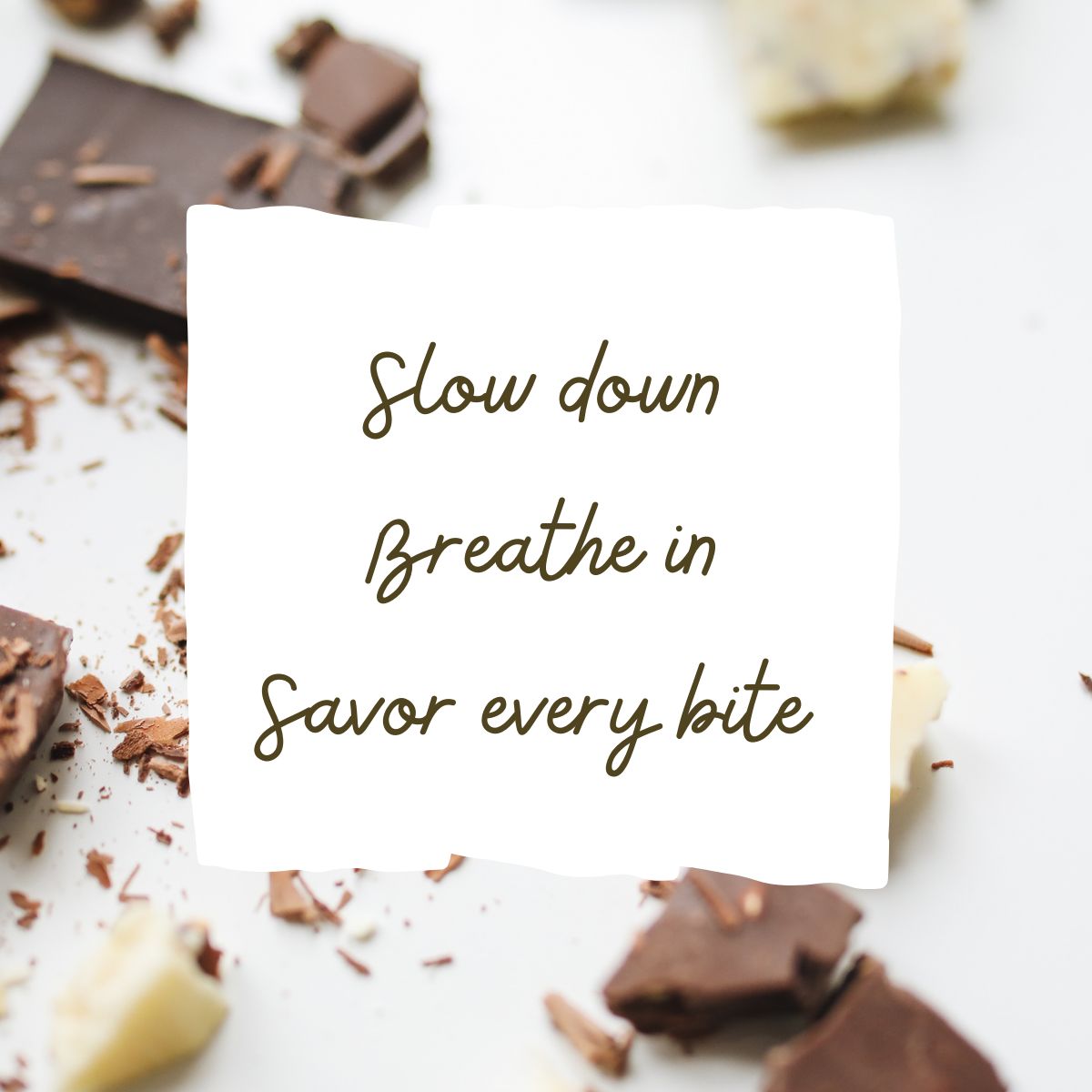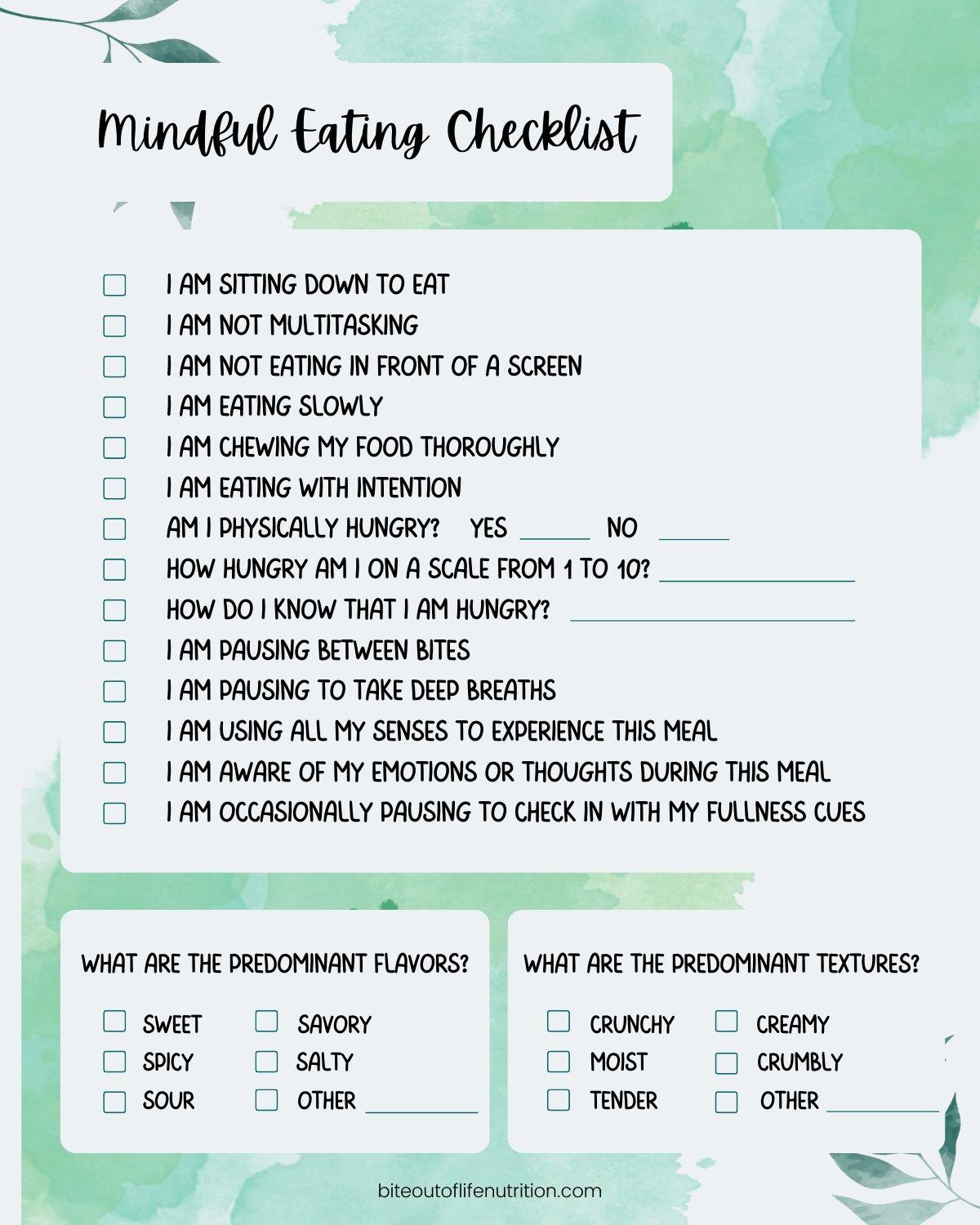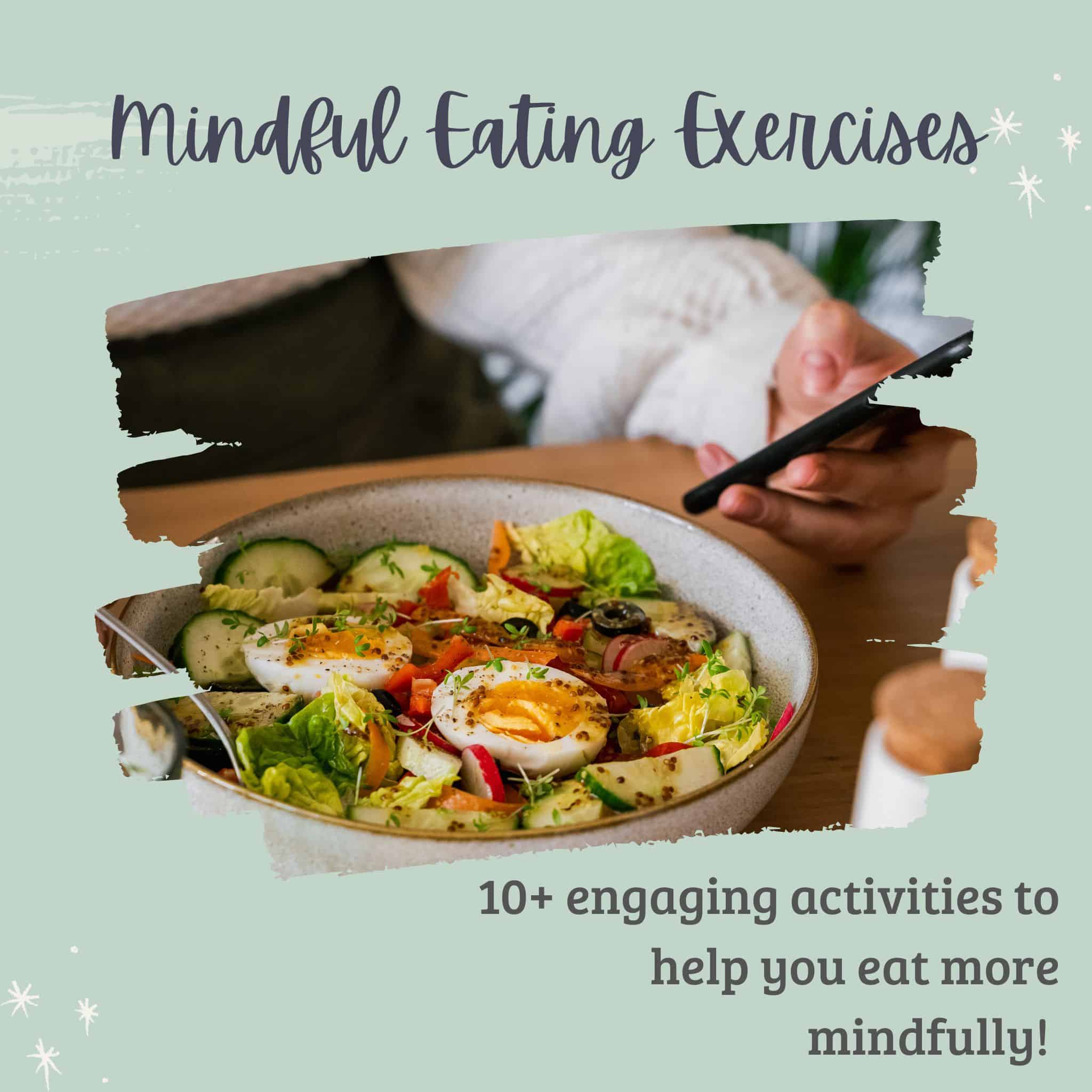We all eat on autopilot occasionally, whether it is multitasking during our lunch break or finishing a bag of chips before we realize that we are eating. Eating mindlessly happens to us all, and that’s perfectly okay. However, it may be a problem when this automatic eating becomes a habit.
In fact, consistent unconscious or mindless eating can lead to anxiety, overeating, poor digestion, and a tendency to use food as a coping mechanism.
Mindful eating can help. Mindful eating reduces stress, improves the mind-body connection, and stops emotional and mindless eating. Plus so much more!
Below you’ll find 10 mindful eating exercises that will help you slow down, focus on your food, and identify your hunger and fullness cues. These exercises are perfect for all levels, including beginners and those looking to expand their mindful eating practices further.
Table of Contents
What Is Mindful Eating?
Mindfulness is a philosophy that dates back centuries and is part of many cultures. Simply put, mindfulness means bringing awareness to one’s thoughts, emotions, and physical state in the present moment. With practice, mindfulness allows us to be more proactive (versus reactive) in our daily lives.
Mindful eating is part of this broader concept of mindfulness and involves being fully present while eating.
Eating mindfully helps us experience gratitude and enjoyment for the eating experience. It also discourages negative judgment about one’s eating choices, thereby improving one’s relationship with food. Imagine a world where you no longer beat yourself up for your food choices but instead felt the simple pleasure of eating! That is the power of mindful eating.
Mindful Eating Benefits
Mindful eating is not just another fad diet. It’s also not a weight loss diet. Instead, it is a behavioral change that can have physical and emotional benefits.
According to the research, some of the benefits of mindful eating may include:
Healthy eating
Overall, we tend to make better food choices when we pay attention to the food in front of us.
Researchers have found a positive association between mindful eating and healthy eating. One study from 2014 linked mindfulness with healthier snack choices and less mindless or impulsive eating. The researchers also noted that mindfulness might promote healthy eating by encouraging preferences for more nutritious foods (1).
Additionally, a literature review of 68 studies found that mindfulness eating strategies improved eating behaviors such as eating slower, recognizing fullness, reducing serving sizes, and greater control when eating (2).
On the other hand, research has linked distracted or mindless eating with adverse outcomes such as anxiety and stress eating (3).
Lower stress
Research has long established that mindfulness exercises, including mindful eating exercises, may reduce stress and anxiety by helping to reduce cortisol levels. In fact, one recent systematic review and meta-analysis found that practicing mindfulness is integral to managing stress (4).
It makes sense that eating mindfully can reduce stress since it encourages us to eat without distraction. Simply put, mindful eating allows us to slow down, relax, and take a break from daily stressors during meals.
Less emotional and stress eating
The research shows that mindfulness and mindful eating exercises may reduce binge and emotional eating.
Two separate literature reviews found that mindful eating awareness training can decrease the frequency of binge eating and emotional eating episodes, improve self-control around food, and reduce the symptoms of depression in those with binge eating disorder (5, 6).
A more recent literature review found that mindfulness-based approaches to eating appear to be most effective in addressing binge eating, emotional eating, and eating in response to external cues. The researchers hypothesized that mindfulness principles reduce emotional eating by increasing awareness of internal cues to eat, such as hunger and fullness (7).
Mindful Eating Exercises
Are you interested in becoming a mindful eater or expanding your skills further? Mindful eating exercises are a great way to start.
The following mindful eating activities and exercises can help you incorporate the practice of mindful eating into your daily routine. So why not give one of these activities a try? Or even better, try all ten!
Exercise 1: Basic Mindful Eating Strategies
A big part of eating more mindfully involves bringing awareness to your food and meals. Set the stage for an enjoyable meal by starting with some mindful eating basics.
Some basic mindful eating strategies are:
- Sit down and eat without distraction
- Avoid multitasking or eating on the go
- Try eating with all of your senses. How does your food look, taste, smell, and sound?
- Bring your awareness to the meal in front of you. What do you find pleasing about this meal? What tastes or textures do you notice?
- Eat slowly and savor your food. If you are new to mindful eating, consider setting a timer for 20 minutes, so you don’t rush through your meal.
- Pause between bites. Notice what your body and mind are telling you.
- Take smaller bites and chew your food thoroughly before moving on to the next.
- Practice gratitude for the food that is before you
Exercise 2: The Hunger Scale
The mindful eating hunger scale is a helpful tool to measure your appetite on a scale from 1 to 10, with 1 being ravenous and 10 being completely stuffed. Using the hunger scale can help you reconnect with your hunger/fullness cues so that you can eat when you’re hungry and stop when you’re comfortably full.
Here is a summary of the hunger scale:
- The Tank is Empty- You are feeling empty, ravenous, and starved.
- Ravenous or Uncomfortably Hungry- You are noticing intense or uncomfortable hunger pangs. You might also label this as too hungry.
- Very Hungry- You have strong hunger cues. You’re ready to eat and feeling very hungry.
- Getting Hungry – You are noticing the first signs of hunger. Your body is signaling that it is ready or almost ready for food.
- Neutral- Neither hungry nor full. Your mind can focus on things other than food.
- Satisfied and Light- You’re no longer hungry and just beginning to feel full.
- Comfortably Full- You are comfortably full. You feel confident that you can remain satiated for the next few hours.
- Too Full- Feeling like you ate more than you needed to.
- Very Full or Stuffed- Uncomfortable, bloated, and sluggish. Eating any more may even make you feel sick or nauseous.
- Feeling Sick or Painfully Full- Far past the point of comfort and on the verge of being sick. You might describe this as “Thanksgiving Day full.”
As a general rule, you want to start eating when you are at a 3 or 4 and stop around 6 or 7. In other words, not too hungry and not too full. Don’t wait until you are at a 1 or 2 to start eating. Being very hungry tends to backfire and cause us to overcompensate by eating more or faster than we usually would.
Exercise 3: The Balanced Plate Activity
The Balanced Plate Activity is a mindfulness eating exercise that will help you slow down and focus on the physical sensations of eating a well-balanced meal.
Many individuals report feeling fuller and more satisfied after consuming a balanced meal- that is, a meal that consists of a carb, protein, and fat.
For this mindful eating exercise, you’ll need to set aside about 25 to 30 minutes for your meal. Here’s how to try the balanced plate activity:
- Serve yourself a plate that consists of ¼ protein, ¼ carbohydrate, ½ nonstarchy veggies, and at least one serving of fat.
- Slowly enjoy half of your balanced meal, taking moments to breathe and pause between bites.
- After you finish the first half of your meal, pause for about 5-10 minutes.
- After this break, check in with your body and hunger/fullness. Are you still hungry? If the answer is yes, then skip to step 6.
- If you feel satisfied, end your meal here. Package and store the leftovers in the fridge for another time. Take a few moments to reflect on your fullness. What cues told you that you were satisfied?
- If you’re still hungry, divide what is remaining on your plate in half again and eat half of what is there.
- After you eat this half, pause for another 5-10 minutes. Again, check in with your body and whether or not you feel satisfied.
- Repeat this process until you feel full and satisfied with your meal.
Let’s reflect:
- What did you notice about eating in this way?
- What components of the meal were most satisfying and why?
- What signals or cues told you that you were full? How will you use these cues in the future to better understand your fullness?
Exercise 4: Keep a Mindful Eating Journal
Try keeping a mindful eating journal of your meals and snacks. Journaling is an excellent way to practice gratitude and bring greater awareness to your internal dialogue.
It also aids in processing emotions and can help you identify why you eat, especially if you’re prone to eating for reasons other than physical hunger. You might start to notice patterns over time, such as boredom eating or eating to soothe an uncomfortable emotion.
In this mindful eating journal, you may want to describe your meal, how it made you feel, your emotions, or what you were doing before eating.
Some mindful eating journal prompts include:
- How would I describe this meal?
- What did I enjoy most about this meal?
- Which tastes or textures did I like the most?
- How hungry was I on a scale from 1-10, and how might this have impacted my choices?
- Do I trust my body to tell me how much food it needs? Why or why not?
- What emotions trigger me to eat?
- What foods do I usually turn to when I am avoiding an emotion?
- Why is it important for me to nourish my body?
- What is my current relationship with food, and what would I like to change about this relationship (if anything)?
- What “food rules” do I set for myself? (e.g., I can’t eat after 7 pm or I never eat sugar).
- How might my life be better without strict “food rules”?
Exercise 5: The Mindful Eating Plate
The Mindful Eating Plate is a creative take on the MyPlate method that provides a visual reminder of the different aspects of mindful eating. It comes from Dr. Susan Albers, an author and expert on mindful eating.
Like MyPlate, the Mindful Eating Plate divides a standard dinner dish into four sections. These sections represent:
- Observe: Notice your body (rumbling stomach, low energy, stressed out, satisfied, full, empty).
- Savor: Notice the texture, aroma, and flavor. Is your meal crunchy, savory, sweet, salty, smooth, spicy, etc.?
- In-the-Moment: Be fully present and free from distractions while eating.
- Nonjudgment: Approach food mindfully and compassionately. Remove self-judgment from eating. Notice when “shoulds,” rigid diet rules, or guilt pops into your mind and think of ways to reframe those thoughts.
Plus, there is a glass next to the plate to represent awareness:
- Aware: Tasting your food vs. mindlessly eating.

Exercise 6: Describe Each Bite
For this mindful eating exercise, you’ll take note of and describe each bite of food. Have you ever noticed that the first bite of something delicious often tastes better than the subsequent bites? This is because our taste buds quickly adapt to a new flavor.
During this mindful eating activity, notice the changes and subtle differences that occur with each new bite.
Begin by serving yourself a mindful meal, then slowly and deliberately take a bite. Make a note of how the first bite tastes. Does it taste as good as you imagined? Continue like this until the meal is complete or you are full, whichever comes first.
Depending on the size of the meal, you don’t necessarily need to do this with every single bite. However, try to take notes every few bites. For example, how does the first bite compare to the fourth or fifth? How does it compare to the last bite? What do you notice in terms of flavor and texture changes?
Exercise 7: Learn Your Emotional Triggers
Emotional eating is not uncommon, and we sometimes turn to food to soothe uncomfortable emotions. After all, who hasn’t mindlessly munched on chips or cookies after a long day? Or reached for chocolate out of sadness or boredom?
While occasional emotional eating is a perfectly okay coping mechanism, it can lead to problems if eating becomes your primary form of comfort. For some, emotional eating can also cause issues such as overeating, intense food craving, and feelings of guilt and shame.
Try the following mindful eating activity to help stop emotional eating:
- Begin by asking yourself if you are physically hungry. If the answer is yes, then eat!
- If the answer is no, take a few moments to consider how you are feeling. What emotions are you experiencing? Is it anxiety, anger, sadness, boredom, exhaustion, loneliness, etc.?
- Ask yourself, will eating right now fix this emotion, or will I still feel like this when I finish eating? Emotional eating does little to solve a problem for most people and can even make us feel worse because it may lead to food guilt.
- Consider what may actually help address these emotions. Perhaps you need sleep, relaxation, or human connection; food cannot appropriately satisfy any of these needs.
Additional strategies to help overcome emotional eating include eating a well-balanced diet, practicing mindfulness, and not letting yourself get too hungry or “hangry.”
Exercise 8: Practice Eating Slower
Part of mindful eating is slowing down so we can enjoy our food and the eating experience. Try some of these simple tips to eat slowly:
- Put your fork down every few bites.
- Take a few deep belly breaths between bites. Not only will this slow your eating, but deep breathing also helps reduce stress and improve mindful awareness.
- Eat with your non-dominant hand. Eating with your non-dominant arm requires more effort and concentration, allowing us to bring our attention to the meal. Plus, it never hurts to strengthen coordination on our weaker side.
- Thoroughly chew your food. Don’t take another bite until you’ve finished with the current one.

Exercise 9: Rotate Bites of Food
Have you ever noticed that the first few bites of food taste the best? This is because our taste buds learn to recognize and quickly adapt to the new taste sensation. It can be easy to fall into a cycle of overeating as we try to chase feel-good chemicals from the first bite.
Try rotating bites of the different foods on your plate for this mindful eating exercise to keep your taste buds guessing.
Exercise 10: The Mindful Eating Checklist (plus free PDF)
This checklist is a handy reminder of multiple mindful eating techniques and strategies in one place. It is perfect for beginners who want to make conscious eating part of their lifestyle. Try using the mindful eating checklist during your next meal to start building the habit of mindful eating.
Click here for the Mindful Eating Checklist PDF
- I am sitting down to eat
- I am not multitasking
- I am not eating in front of a screen
- I am eating slowly
- I am chewing my food thoroughly
- What am I doing during this meal?
- I am eating with intention
- Am I hungry? Yes or No
- How hungry am I on a scale from 1 to 10?
- How do I know that I am hungry?
- I am pausing between bites
- I am pausing to take deep breaths
- I am using all my senses to experience this meal
- Am I aware of the flavors of this meal?
- What are the predominant flavors?
- I am aware of the textures of this meal
- What are the predominant textures?
- I am aware of my emotions or thoughts during this meal
- I am occasionally pausing to check in with my fullness cues

Final Thoughts
Mindful eating exponentially increases the enjoyment and satisfaction we get from our meals. It can also curb mindless and emotional eating and improve our relationship with food.
However, you can’t build mindfulness eating skills overnight. It takes practice. These fun and engaging mindful eating exercises are an excellent way to develop deeper mindfulness eating habits. So why not try one or more of these mindful eating activities?
Check out this free 7-day mindful eating challenge if you’re interested in learning even more tips and tricks for mindful eating.

